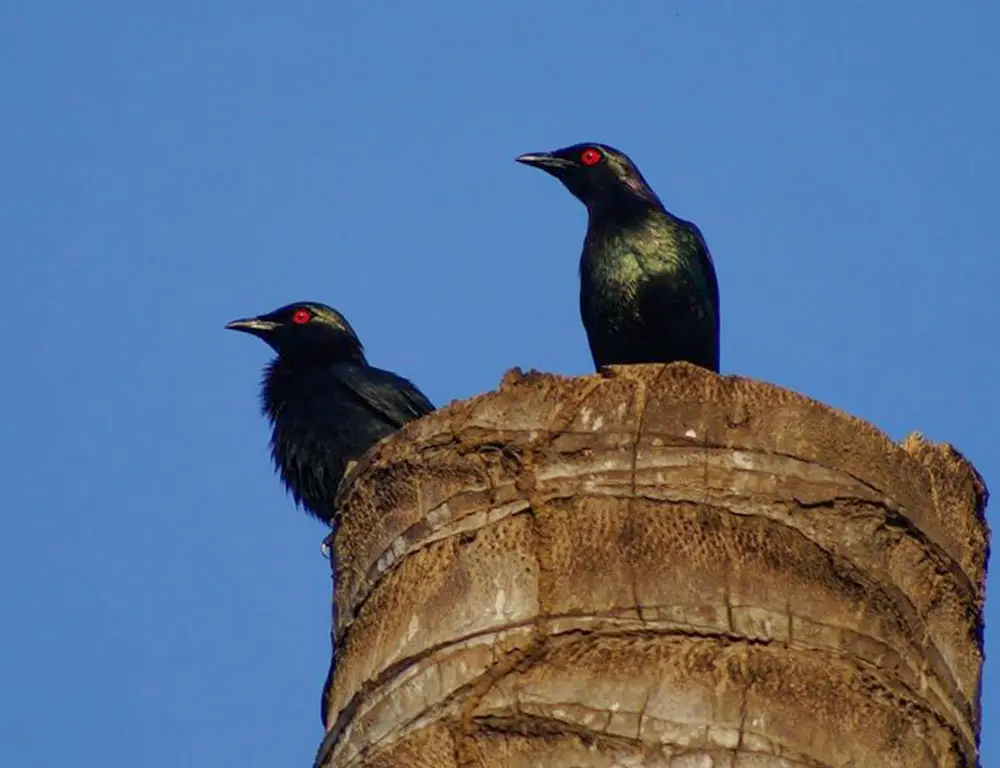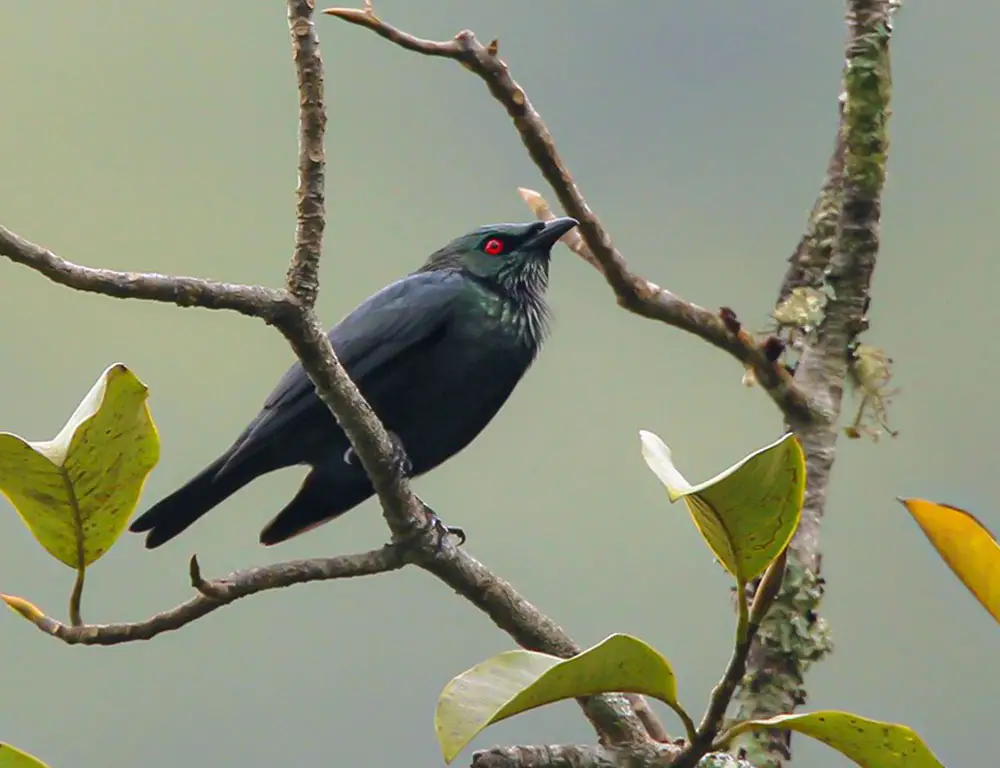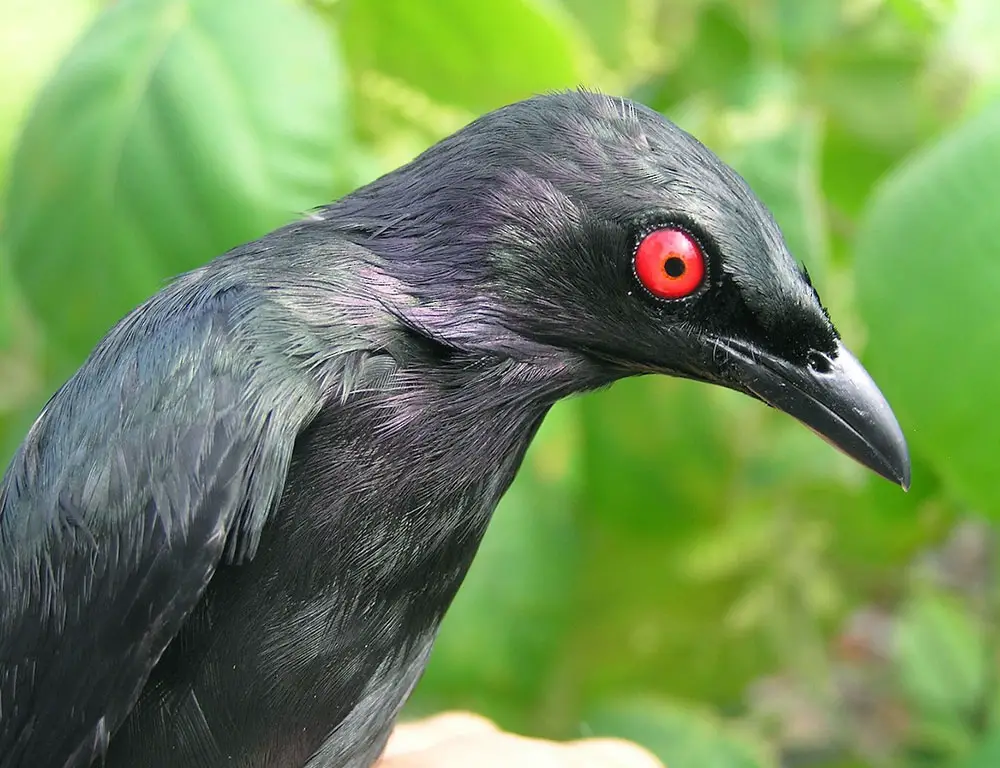Exploring the realms of avian diversity unveils the intriguing presence of the Short-Tailed Starling, scientifically known as Aplonis minor. Amidst the tropical islands of Micronesia and Melanesia in the Pacific Ocean, this bird stands as a testament to adaptation and survival.
Despite its understated appearance compared to more ostentatious relatives, the Short-Tailed Starling thrives within the diverse ecosystems of these tropical paradises.
Offering a captivating study of bird behavior and ecology, these social creatures navigate their surroundings in communal flocks, highlighting their innate sociability and cooperative nature.
With glossy plumage adorning their frames and distinctive calls resonating through the air, Short-Tailed Starlings uniquely charm the vibrant tropical biodiversity tapestry.
Physical Characteristics of the Short-Tailed Starling

The physical characteristics of the short-tailed starlings contribute to their captivating allure and make them intriguing subjects for bird enthusiasts.
Here’s a closer look at their size, weight, and distinctive coloration:
Size and Weight
Short-tailed starlings are relatively small birds, with weights ranging from 60 to 85 grams, approximately the weight of a tennis ball. Their length typically falls within the 20 to 23 cm range, including their notably short tail.
While males are slightly larger on average than females, the difference is often minimal and may not be readily apparent to human observers.
Coloration
The color palette exhibited by short-tailed starlings is a key feature contributing to their enchanting allure.
- Body Color: They boast an iridescent blackish-blue plumage that appears glossy, especially under sunlight. This metallic sheen makes them look mystical and striking in their natural habitat.
- Wing Patches: Their wings feature prominent white patches that become vividly apparent when spread out in flight. These stark white wing bars contrast dramatically against their dark bodies, enhancing their aesthetic appeal.
- Eye Color: Short-tailed starlings are further distinguished by their bright yellow eyes, adding another layer of intrigue to their overall color scheme.
Habitat and Distribution of the Short-Tailed Starling
The Short-Tailed Starling (Aplonis minor) prefers high-altitude mountainous regions and demonstrates remarkable adaptability to various environments within this habitat range.
Here’s a closer look at their natural habitat and geographic distribution:
Natural Habitat
- Altitude Preference: Short-tailed starlings are commonly found in mountainous regions, favoring altitudes ranging from 900 to 2700 meters above sea level.
This unique habitat preference reflects their adaptation to cool climates and specific vegetation compositions characteristic of high-altitude ecosystems. - Vegetation Preference: They thrive in primary and secondary forests within their preferred altitude range, often favoring mossy trees and bamboo habitats. These plant species are standard fixtures in the Short-Tailed Starling’s dwelling places, providing them with suitable nesting sites and food sources.
- Human Settlements: Interestingly, Short-Tailed Starlings are not opposed to human settlements and can often be spotted around gardens or agricultural lands close to forests. As long as trees are present, these adaptable birds feel at home even in human-inhabited landscapes near forest edges.
Geographic Distribution
Short-Tailed Starlings have a broad geographic distribution across Southeast Asia, with hotspots including Indonesia, Malaysia, Thailand, Vietnam, and Myanmar.
- Indonesia: They are found across various islands, including Sumatra, Java, Bali, and Borneo.
- Malaysia: Short-tailed starlings are commonly sighted in Malaysia.
- Thailand: They are found in various regions throughout Thailand.
- Vietnam: These birds are spotted in northern areas of Vietnam.
- Myanmar: Short-tailed starlings are present in the northern regions of Myanmar.
Behavior and Diet of the Short-Tailed Starling

Let’s dive into the fascinating details of the behavior and diet of the Short-Tailed Starling. These birds exhibit intriguing social behaviors, while their feeding habits tell a tale of adaptability and survival.
Social Behavior
I’ve always found it remarkable how certain bird species interact within their communities, and the Short-tailed Starling is no exception.
They’re known for their friendly nature, often seen in large groups or flocks. Whether it’s nesting season or they’re out foraging for food, you’ll frequently spot these starlings together.
During the breeding season, however, things get interesting. Male Short-tailed Starlings become quite territorial around their nests. It’s not just about competition, though – this behavior also plays a vital role in attracting females.
The males display spectacular displays, showing their vibrant plumage to prospective mates.
Feeding Habits
Regarding what they eat, these starlings aren’t picky eaters. Omnivorous by nature, they consume both plant-based foods and small animals.
- Their diet mainly consists of fruits like berries.
- Insects make up a significant portion, too.
- They also feed on nectar from flowers occasionally.
- Small amphibians and reptiles are part of their menu when available.
Conservation Status of the Short-Tailed Starling

The conservation status of the Short-Tailed Starling (not a natural bird species) reflects a positive trend, with the species currently classified as “Least Concern” on the International Union for Conservation of Nature (IUCN) Red List.
However, it’s essential to remain vigilant and proactive in preserving their habitats and monitoring their populations to ensure their continued well-being.
Let’s delve deeper into their conservation status and the measures being taken to protect them:
Current Status
The Short-Tailed Starling is categorized as “Least Concern,” indicating that it is not currently facing imminent threats of extinction. This designation is a positive sign, suggesting that their populations are relatively stable and their habitats are not severely degraded.
Population Trend
Over the past two decades, there has been a gradual increase in the population of Short-Tailed Starlings. From 2000 to 2020, their estimated population has grown from 1.2 million to 1.5 million individuals.
This upward trend is encouraging and suggests that conservation efforts may effectively support their populations.
Conservation Measures
Several initiatives are underway to protect Short-Tailed Starlings and their habitats:
- Forest Preservation: Protecting forests from excessive logging helps maintain vital habitats for the Short-Tailed Starling and numerous other species. Preserving these ecosystems safeguards biodiversity and ensures the availability of resources for the starlings.
- Pollution Control: Implementing stricter regulations on industries can reduce harmful pollutants that may affect bird populations. Controlling pollution helps maintain the health of ecosystems and minimizes threats to the starlings’ well-being.
- Climate Action: Addressing global warming and its impacts on habitats is crucial for the long-term survival of the Short-Tailed Starling. Mitigating climate change can help prevent habitat loss, extreme weather events, and other disruptions that may threaten their populations.
Continued Vigilance
While the current conservation status and population trend of the Short-Tailed Starling are positive, continued vigilance is essential.
Monitoring their populations and habitat conditions ensures that any emerging threats can be addressed promptly, helping to sustain their positive trajectory.
Conclusion
The Short-Tailed Starling emerges as a resilient and adaptable bird, showcasing remarkable survival skills across diverse habitats.
Their ability to adjust their diet and navigate dense foliage with their short tail underscores their importance in maintaining ecosystem balance.
As significant contributors to seed dispersal, they are crucial to the health of their habitats. However, they face threats from habitat loss and human activities. Understanding and conserving these avian wonders is paramount for preserving biodiversity.
Let’s appreciate and protect every creature, including the Short-Tailed Starling, recognizing their intrinsic value in our natural world. Hopefully, this exploration has piqued my curiosity about ornithology and the importance of ecological conservation.
As I conclude, let’s cherish every bird and commit to safeguarding their habitats for generations.